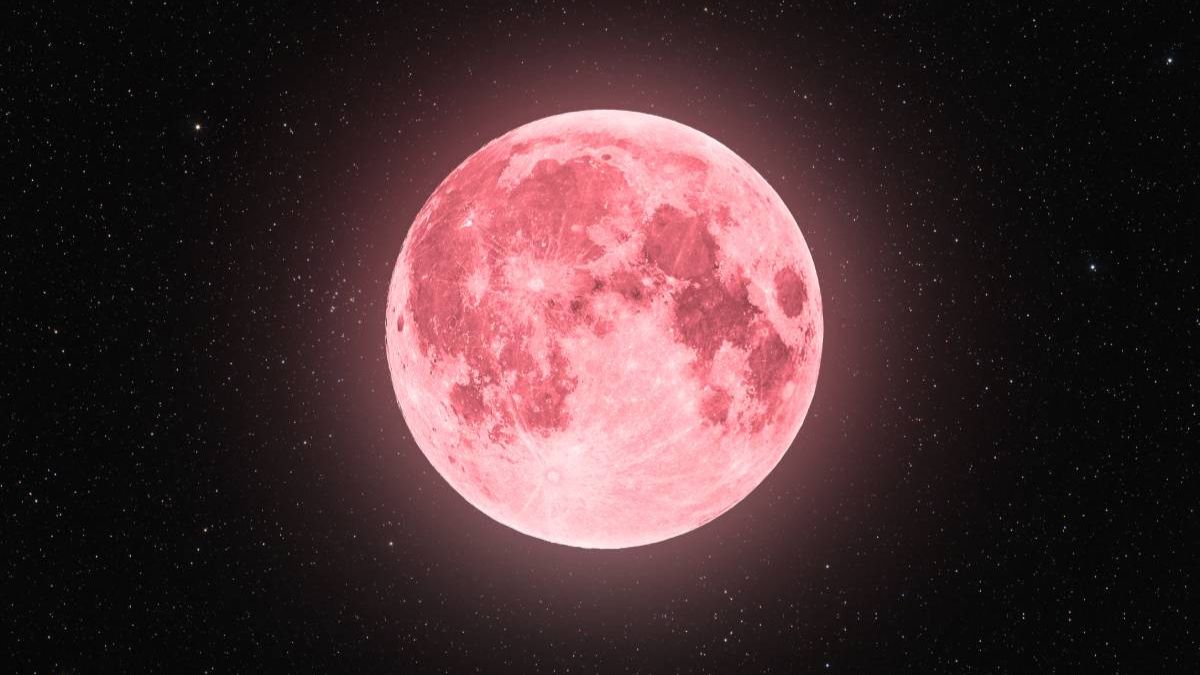Step outside on Saturday, April 12, to witness April’s full Pink Moon. This Paschal Moon marks the first full Moon of spring and is used to determine the date of Easter. This month also brings a micromoon. Curious about how it compares to a supermoon? Discover the story behind the “Pink Moon” and what makes this lunar event unique. Step into the glow of April’s Pink Moon a celestial wonder rich with astronomical, spiritual, and seasonal significance. Learn why this full Moon matters more than meets the eye.
What Is the Pink Moon, And Is It Really Pink?
Let’s clear the cosmic confusion: Despite its charming name, the Pink Moon does not radiate pink light. Instead, this traditional name stems from the bloom of moss pink (Phlox subulata) a ground-hugging, bubblegum-colored wildflower signaling the heart of spring.
The name “Pink Moon” belongs to a rich lineage of seasonal Moon names, drawn from Indigenous American, Colonial, and European traditions designed to track the seasons and harvests through lunar cycles.
Atmospheric Magic: Why the Moon Might Look Colored
As the Pink Moon rises above the horizon, it may take on hues of gold, peach, or rose, thanks to atmospheric refraction. Dust, water vapor, and particles scatter shorter blue wavelengths, leaving behind the longer red-orange wavelengths, resulting in a dreamy visual spectacle, especially when viewed from areas with clear skies and low light pollution.
When to Watch the 2025 Pink Moon
- Full Moon Date: Saturday, April 12, 2025
- Peak Brightness: 8:22 PM EDT | 00:22 GMT (April 13)
- Moonrise: Shortly after local sunset check [Moonrise times by location]
The most stunning views occur when the Moon hovers just above the horizon. Use landmarks to enhance the illusion of grandeur!
This is the fourth full Moon of 2025 and a perfect opportunity to engage in moon watching, astrophotography, or simply absorbing the cosmos.
A Micromoon: The Hidden Twin of a Supermoon
Most stargazers have heard of the supermoon, but few appreciate its lesser-known sibling: the micromoon.
On April 12, 2025, the full Moon occurs just 22 hours before it reaches apogee its farthest point from Earth. This makes it about 14% smaller and 30% dimmer than a supermoon.
| Type | Distance from Earth | Apparent Size |
| Supermoon | ~356,000 km | Largest & Brightest |
| Micromoon | ~406,000 km | Smaller & Dimmer |
Why Does the Distance Change?
The Moon’s orbit is elliptical, not a perfect circle. These slight fluctuations influence tidal forces, eclipse timing, and the Moon’s visual presence in the night sky. While the difference in size is subtle to the naked eye, photographers often notice the contrast in lunar surface detail.
Paschal Moon: The Lunar Calendar’s Sacred Role
The April 2025 Pink Moon is also the Paschal Moon a title rich in Christian tradition and astronomical calculation.
How It Sets Easter’s Date
Easter is not fixed on the calendar. Instead, it is celebrated on the first Sunday after the Paschal Full Moon, which is the first full Moon following the ecclesiastical spring equinox (set as March 21).
- Equinox (Ecclesiastical): March 21
- Paschal Full Moon: April 12
- Easter Sunday (2025): April 20
This celestial rule is ancient and deliberate, blending solar, lunar, and liturgical calendars to ensure Easter always falls in spring, after the renewal of both the Earth and the Moon.
Cultural Lore: April’s Many Moon Names and Meanings
Across cultures, April’s full Moon has inspired a mosaic of meanings. Here’s a closer look:
| Culture | Moon Name | Meaning |
| Algonquin | Breaking Ice Moon | Melting rivers signal travel and trade resume |
| Dakota | Moon When Streams Are Navigable | End of winter freeze, return of life to waterways |
| Oglala | Moon of the Red Grass Appearing | Marks the return of spring flora |
| Lakota | Moon When the Ducks Come Back | Honoring animal migrations |
| Cree | Frog Moon | First frog songs echo the coming warmth |
| Anishinaabe | Sucker Moon | Sacred time of fish returning to cleanse the waters |
These names reflect how ancient peoples observed nature’s cues, woven into rituals, hunting calendars, and myths.
Why the Moon Appears Larger on the Horizon
This phenomenon, known as the Moon illusion, is a psychological trick. Although the Moon’s size doesn’t physically change, our brain perceives it as enormous when it’s close to familiar objects on the horizon, like trees or buildings. As it rises, it returns to its true apparent size.
Even a micromoon can seem majestic under the right conditions.
Moon Explorers & Modern Legends
April also holds a special place in human lunar exploration:
- Apollo 16 Moon Landing: April 20, 1972
- First Lunar Rover Drive: April 21, 1972 — Astronauts John Young and Charles Duke became the first to drive on the Moon, aboard a rugged electric rover that remains parked on the lunar surface.
Fun Fact: NASA left tools, cameras, and even astronaut footprints behind frozen in time, untouched for over 50 years.
Folklore and Farming: Gardening by the Moon
Ancient farmers and modern homesteaders alike follow lunar gardening traditions tied to full Moon phases. According to folklore:
Full Moon to Last Quarter: Best for pruning, weeding, harvesting, and cutting timber
Last Quarter to New Moon: Ideal for rest and soil preparation
New Moon to First Quarter: Time for planting leafy crops above ground
First Quarter to Full Moon: Great for root crops and transplanting
These traditions arise from observed correlations between gravitational lunar pull, moisture in soil, and plant behavior.
Why the Moon Still Captivates Us
Even in our age of high-tech telescopes and Mars missions, the Moon continues to cast a spell over humanity.
- It shapes the tides.
- It governs ancient festivals.
- It inspires poets and guides calendars.
- It connects us to a natural rhythm that transcends borders and eras.
The April Pink Moon is more than a pretty name. It’s a celestial signal, a spiritual anchor, and a scientific phenomenon all in one. As a micromoon, a Paschal Moon, and a seasonal marker, it invites us to look up and remember our place in a universe full of hidden connections. Whether viewed as a scientific body, a spiritual mirror, or a cultural muse, the Pink Moon is a reminder that we are part of a vast, unfolding cosmos and that wonder still rises, softly, above the eastern horizon. So if the skies are clear, don’t miss it.



